Massoud M. Engineering Thermofluids: Thermodynamics, Fluid Mechanics, and Heat Transfer
Подождите немного. Документ загружается.

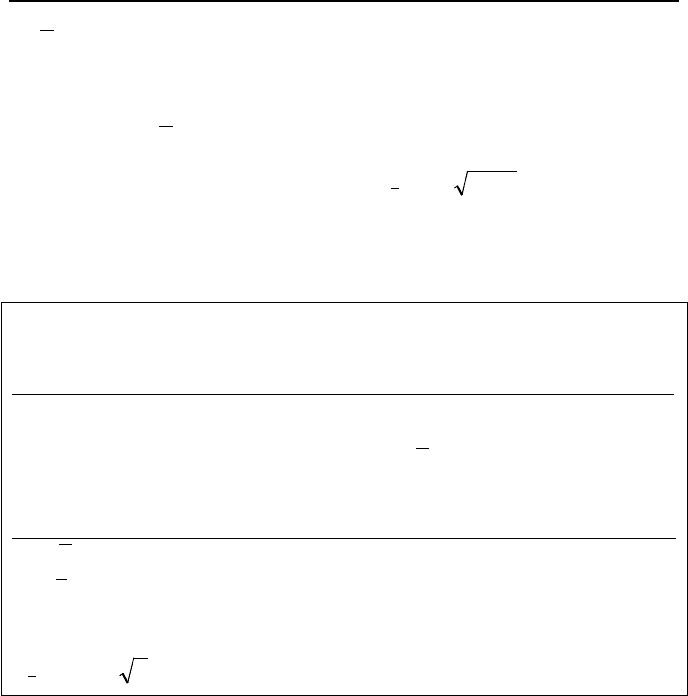
732 VIb Applications: Fundamentals of Flow Measurement
NLL
N
i
i
/
1
¦
=
=
or
σ
being the standard deviation given by:
NLL
N
i
i
/)(
1
22
¦
−=
=
σ
the error in measurement is estimated from
1/ −= Ne
L
σ
where the error is
enhanced by subtracting unity from the number of observations to account for the
fact that the true value of the length is not known.
Example VIb.2.2. The length of a ruler is measured 10 times and the following
readings are obtained. Find the most probable error.
Reading: 1 2 3 4 5 6 7 8 9 10
Length (m): 3.97 3.82 4.10 4.01 4.16 3.87 4.15 4.05 3.89 3.92
Solution: Arithmetic average of the readings is 994.310/94.39 ==L m. Set
up the following table:
Reading: 1 2 3 4 5 6 7 8 9 10
LL
i
− : -0.024 -0.174 0.106 0.016 0.166 -0.124 0.156 0.056 -0.104 -0.074
2
()100
i
LL−×: 0.058 3.030 1.12 0.026 2.75 1.54 2.43 0.314 1.08 0.55
Standard deviation is then found as
σ
= (0.1047/10)
1/2
= 0.102 m. Hence,
=
L
e 0.135/ 9 = 0.034 m.
3. Flowmeter Types
Recall that for fully developed flow, velocity varies as a function of pipe radius
across the flow area and mass flow rate is given by (Equation IIb.2.3):
³
⋅=
A
AdVm
K
K
ρ
This equation was simplified for a stationary control surface, flow area normal to
the control surface, and the uniform thermodynamic state uniform over the flow
area at any instant to obtain Equation IIa.5.2, V
K
ρρ
== AVm . A flowmeter may
then measure local flow velocity (
V
K
), volumetric flow rate ( AV
K
=V ) or mass
flow rate (
m
).
Flowmeters can be divided into several categories based on such factors as type
of flow parameter to measure, cost, induced pressure drop, type of fluid, accuracy,

3. Flowmeter Types 733
etc. A large class of flowmeters includes those meters that measure a change in
the flow momentum. Examples of this class include the Bernoulli obstruction me-
ters such as venturi, nozzle, and thin plate orifice as discussed in Section IIIb.4.2.
Also included in this class are such devices as rotameter, pitot tube, and 90 de-
gree elbows. Another large class of flowmeters includes instruments that measure
the volumetric flow rate. Examples of this class include positive displacement of
fluid and such devices as electromagnetic, vortex shedder and turbine meters. De-
vices that also measure volumetric flow rate and are noninvasive include the Laser
Doppler anemometer, ultrasonic flowmeter, and pulsed neutron activation meters.
To measure mass flow rate directly, such techniques as thermal mass flow meas-
urement, Coriolis force meter, and angular momentum measurement are used. A
summary of various types of flowmeters is shown in Table VIb.3.1, which pro-
vides information useful in the selection of flowmeters.
Depending on the application, as shown in Table VIb.3.1, the disadvantage of
invasive floweters is the associated pressure loss. The invasive flowmeters are de-
fined as those that cross the flow boundary. On the other hand, the noninvasive
flowmeters, measure the flow by indirect means and are not associated with any
head loss nor do they need to be integrated in the piping. For invasive flowmeters,
it is important to install the device so that flow entering and leaving the instrument
is not disturbed by the presence of fittings and valves. Manufacturers generally
specify the minimum distance required upstream and downstream of the pipe.
This distance is specified in terms of the diameter of the pipe on which the device
would be installed. On occasions that such a possibility does not exist due to
space limitations, a flow straightener is used to streamline the flow.
3.1. Momentum Sensing Flowmeters
Orifice, Nozzle, Venturi. The most famous momentum sensing instruments
are Bernoulli obstruction meters as were discussed in Section IIIb.4.2. Ta-
ble VIb.3.1 shows that the orifice has the highest and the venturi has the lowest
pressure loss. The cost of these devices is inversely proportional to the pressure
drop they introduce to the flow. Hence, a venturi is the most expensive and a thin-
plate orifice is the least expensive. The Bernoulli obstruction meters are found in
various sizes. Thin plate orifices can be found as small as 1 inch in diameter. On
the other hand the world’s largest flowmeter is a venturi made for Southern Ne-
vada Water authority. The diameter of this flowmeter is 180 inches (4.6 m), hav-
ing a dry weight of 60,000 lbm and a volume of 6400 ft
3
to measure a water flow
rate in excess of 555,000 GPM (35 m
3
/s). The venturi flowmeter is 52 ft (15.85 m)
long (Flow Control Magazine).
Rotameter: the trade name of a manufacturer has been applied to the variable
area meter. Such meters consist of a tapered tube oriented vertically and a float as
shown in Figure VIb.3.1(a). There are three forces acting on the float, the drag
force (F
D
), as a result of the external flow of fluid over the float, the buoyancy
force (F
B
) and the float weight (F
W
). When F
W
= F
B
+ F
D
then the float is at equi-
librium and the flow rate is read from a calibrated scale.
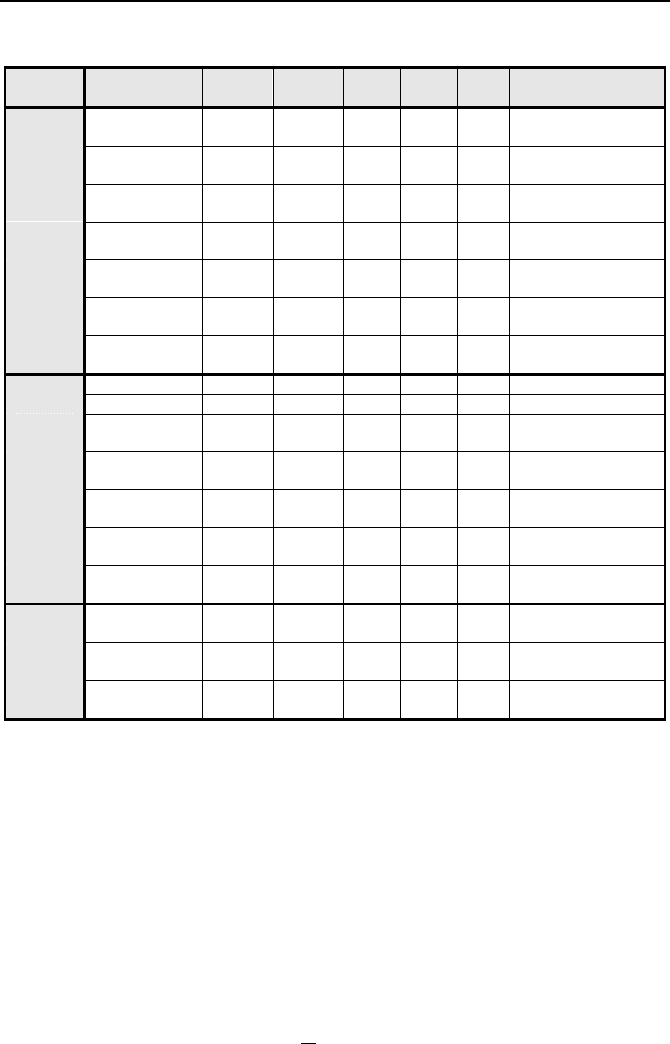
734 VIb Applications: Fundamentals of Flow Measurement
Table VIb.3.1. Comparison of Various Flowmeters
Class Type Fluid Accu-
racy
Head
Loss
Cost UD/
DD
Advantages &
Disadvantages
Orifice L/G M h l 20/5 Corrosion &
wear: su
Nozzle L/G/T M m m 20/5 High temp. &
velocity: su
Venturi L/G/S/T M l h 15/5 High temp. &
velocity: su
Momen-
tum
Rotameter L/G L m l n Low flow: st,
Pulsating flow: li
Ave. Pitots L/G L l l 30/5 Probe flow
eparation: su
Laminar G L h m 15/5 Pulsating flow:
st, Dirty fluid: li
Elbow L/G/S L l l 25/10 Available
performance data: li
Turbine L/G H h h 15/5 Bearing wear: su
Paddle wheel L/G M l l 15/5 Bearing wear: su
Vortex L/G H h h 20/5 Low flow: ns,
Vibration: su
Volume Electro-
magnetic
L/S/T M n h 5/3 Non-conducting
fluid: su
Ultrasonic L/G/T H n h 15/5 Change in
temperature: st
Laser Doppler L/G/S/T M n h 15/5 Reynolds
Number: li
Positive
displacement
L/G H h l n Dirty fluid: su,
Wear: su
Thermal L/G L m m 5/3 Dirty fluid: su,
Low flow: st
Mass Angular L M m m n Aircraft fuel
flow: st
Coriolis L/G/S H m h N Pipe size: li,
Fouling: su
Table abbreviations:
L: liquid, n: None
G: gas, ns: Not suitable
S: slurry, st: Suitable
T: two-phase su: Susceptible
h: high, li: Limitation
m: medium UD: Straight piping, as multiples of pipe Diameter, required Upstream
l: low DD: Straight piping, as multiples of pipe Diameter, required Downstream
Substituting for weight in terms of float volume and density, for buoyancy in
terms of float volume and liquid density, and for drag in terms of specific kinetic
energy:
()
2/VV
2
VACgg
fFDFfFF
ρρρ
+=
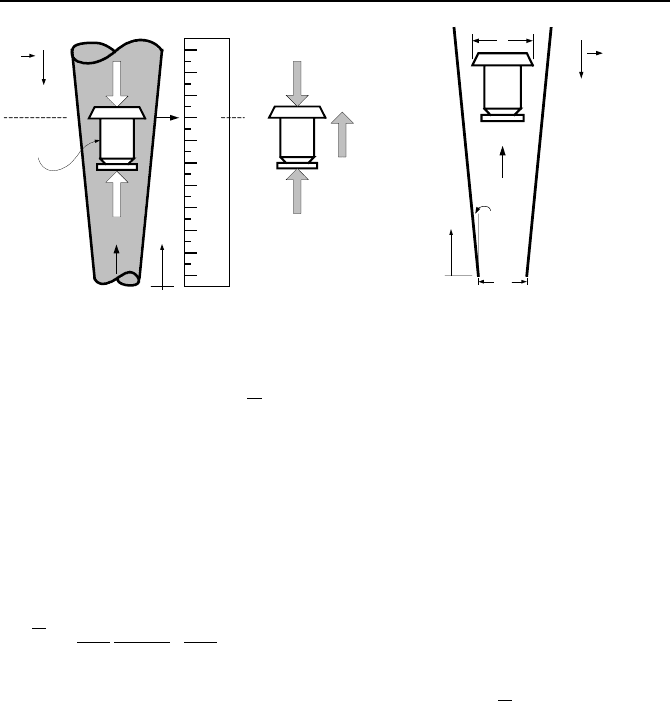
3. Flowmeter Types 735
g
20
0
40
60
80
100
Float
Flow
F
W
F
D
F
B
S
z
b
Flow
θ
α =
tan
θ
g
(a) (b)
Figure VIb.3.1 A variable area flowmeter
where V is the float volume, V is the mean flow velocity, and subscripts f and F
stand for liquid and float, respectively. In this equation, C
D
is the drag coefficient,
which is pertinent to external flow over immersed bodies. For spherical floats, the
drag coefficient is readily available as a function of the Reynolds number. For ex-
ample, experimental data indicate that the drag coefficient for spheres remains
practically constant at 0.5 if the Reynolds number is between 2000 to 200,000. At
higher Reynolds number, the drag coefficient is even smaller. Solving the above
equation for flow velocity:
2/1
1
V2
1
»
»
¼
º
«
«
¬
ª
¸
¸
¹
·
¨
¨
©
§
−=
f
F
F
F
D
A
g
C
V
ρ
ρ
VIb.3.1
The volumetric flow rate can then be calculated from
)(V zAV=
where A(z) =
22
() /4bzS
πα
+−
ªº
¬¼
. Although rotameters are generally made of glass or other
special transparent materials, there are variable area flow meters made of metal
where the reading is obtained by magnetic coupling so that the signal can be re-
ceived and recorded remotely.
Elbow meter, as shown in Figure VIb.3.2(a), takes advantage of the centrifugal
force applied on fluid elements when moving around a bend. The top and the bot-
tom of the 90-degree elbow are drilled at 45 degrees for the insertion of the pres-
sure taps. These pressure taps provide input to a differential-pressure measuring
device (DP-cell), which, upon calibration, would show flow rate in the 90-degree
elbow.
Laminar flowmeters, also known as viscous flowmeters, shown in Fig-
ure VIb.3.2(b), are used to measure gas flow rate based on Equation IIIb.2.3:
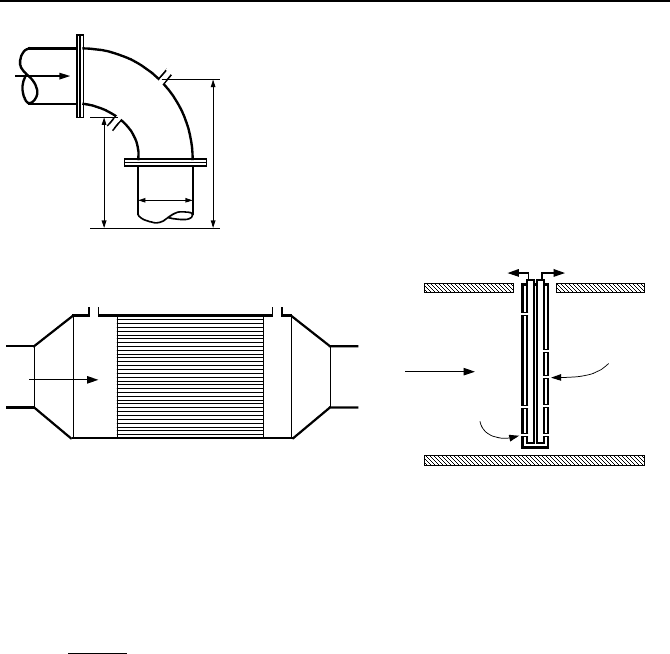
736 VIb Applications: Fundamentals of Flow Measurement
V
A
P
i
P
o
z
i
z
o
(a)
High Pressure
Port
Low Pressure
Port
Flow
(Static
Pressure
Ports)
(b) (c)
Figure VIb.3.2. (a) Elbow meter; (b) Laminar flowmeter; (c) Averaging pitot flowmeter
P
L
D
∆=
µ
π
128
V
4
VIb.3.2
To change the flow regime from turbulent to laminar so that the viscous effects
become dominant, a laminar flow element is used. The laminar flow element con-
sists of capillary tubes with inside diameter as small as 0.01 inches (about 0.23
mm). The pressure taps for differential pressure measurement are located up-
stream and downstream of the laminar flow element.
Averaging Pitot device works on the basis of differential pressure. A bar that
spans the pipe is inserted perpendicular to the flow. The bar may be a circular cyl-
inder or have other profiles such as hexagonal, square, diamond, or elliptic cross
section. Holes are drilled in the side facing the flow and in the downstream side
of the bar, as shown in Figure VIb.3.2(c). The inputs to the pressure taps are car-
ried to individual pressure sensors to be sent to a DP-cell. The advantage of an
averaging pitot tube is its ease of installation and low impact on the flow. Under-
estimating the flow rate is its main disadvantage. This is because of a suction ef-
fect at the static pressure ports, due to the vortices created downstream of the
probe. This is generally taken into account by a flow coefficient in calibration.
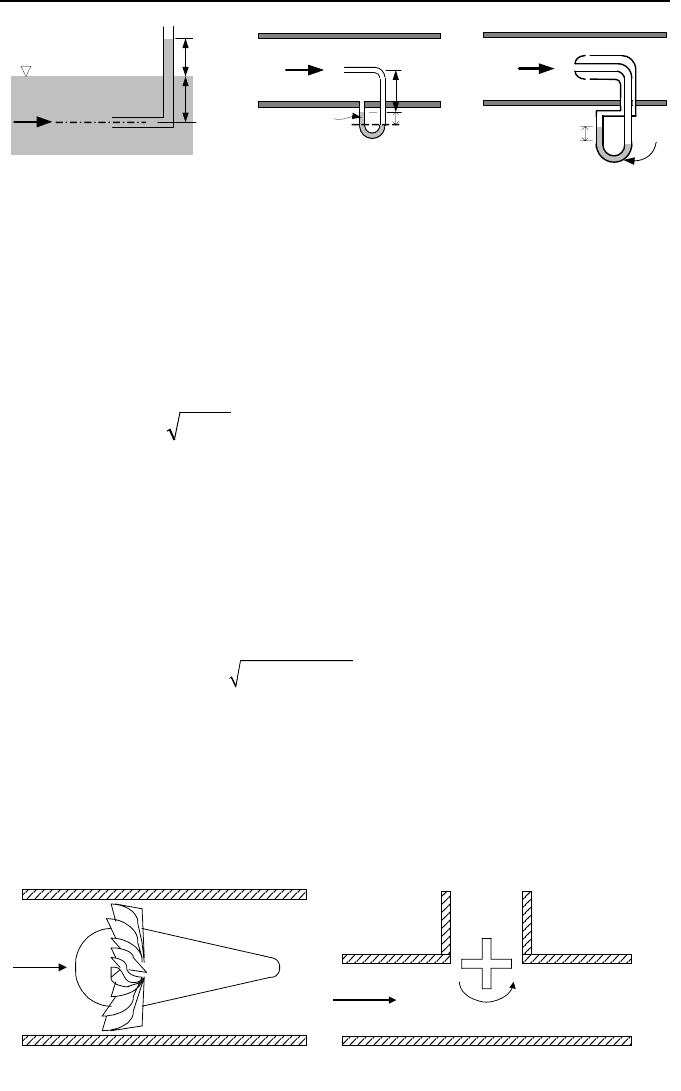
3. Flowmeter Types 737
Flow
2
1
∆h
h
Flow
2
h
S'
S
Flow
1
h
S
S'
L
2
1
aa
(a) (b) (c)
Figure VIb.3.3. (a) Simple pitot tube; (b) Differential pitot tube; (c) Pitot-static tube
(a) (b)
Figure VIb.3.4. (a) Turbine meter and (b) Paddle wheel
It should be added that a pitot tube, invented by Henri Pitot in 1732, is itself a
device for measuring flow velocity. Shown in Figure VIb.3.3(a), is a glass pitot
tube in an open channel. Points 1 and 2 are on a streamline where point 2 is at the
entrance to the tube, hence is at rest. Point 2 is called the stagnation point. Pres-
sure at point 1 is P
1
=
ρ
gh. Pressure at point 2 is P
2
=
ρ
g(h + ∆h). From the Ber-
noulli equation between point 1 and point 2 we have; P
1
+ (
ρ
2
1
V /2) = P
2
. Substi-
tuting, we get
hgV ∆= 2
1
. We derived pressure at point 2 in terms of pressure
at point 1 and pressure related to velocity head. Pressure at point 2 is total or
stagnation pressure as it consists of static and dynamic heads of the flowing fluid.
Shown in Figure VIb.3.3(b) is the differential pitot tube. If the flowing fluid has a
specific gravity of S and the manometer liquid has a specific gravity of S’, a force
balance at the level a-a gives:
12
(h') (h)
ww
P
gLS S P gL S
ρρ
++=++
VIb.3.3
This simplifies to P
2
– P
1
=
ρ
w
gS[(S’/S) – 1]h. On the other hand, P
1
+ (
ρ
w
2
1
V /2)
= P
2
. We find that
[]
1
2h( '/ ) 1VV g SS== −. A more compact system is the pitot-
static tube as shown in Figure VIb.3.3(c). For this case, similar expression can be
derived.
3.2. Volume Measuring Flowmeters
Turbine flowmeter, Figure VIb.3.4(a), and its various forms have been in use for
flow measurement for centuries. The turbine meter consists of a shaft equipped
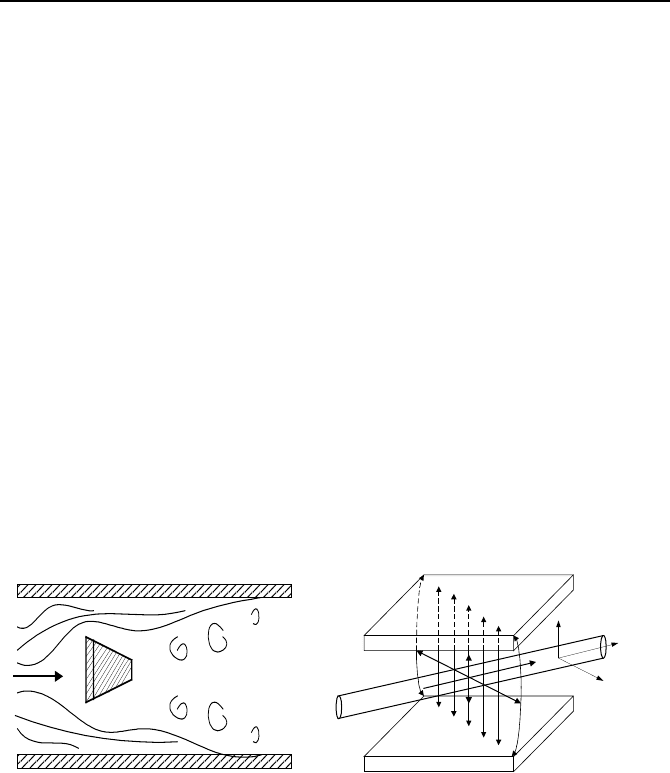
738 VIb Applications: Fundamentals of Flow Measurement
with blades and located centrally against the flow. The shaft and the blades are
designed to minimize the adverse effect on the flow. The flow of fluid through the
blades imparts momentum, causing rotation of the blade, which, in a magnetic
field, produces current proportional to the flow volume passing over the shaft. In
the absence of friction, this proportionality would have been a linear function.
However, various frictional forces result in non-linearity. These forces include
bearing friction, drag on the rotor and the blades, and friction due to the electro-
magnetic effects. Like the turbine meter, there are similar flowmeters, which
work on the transfer of momentum from the flow to a turning wheel. These are
paddle wheel or vane-type and the Pelton-wheel flowmeter, Figure VIb.3.4(b).
Vortex meter is a relatively new concept in flow measurement as the idea was
introduced in the mid 1950s. The device become available in the mid 1970s. In a
vortex meter, a bluff body is placed in the flow field to cause some flow separa-
tions downstream of the bluff body, Figure VIb.3.5(a). As flow increases, so does
the rate of flow separation to a point that the separated flow is rolled back in the
low-pressure area developed behind the bluff body. This backward curl is called a
vortex. As the flow rate is increased, these vortexes grow in size and begin to
travel downstream to form a so-called vortex street. The notable feature of such
vortex-shedding instruments is that the vortexes are formed and depart in alternate
manner from each side of the bluff body. This causes an alternating pressure gra-
dient across the body. The frequency of vortex generation and pressure oscilla-
tions is proportional to flow rate.
V
E
B
x
y
z
(a) (b)
Figure VIb.3.5. (a) Schematics of Vortex flowmeter (b) Electromagnetic flowmeter
Electromagnetic flowmeter works on the basis of Michael Faraday’s law of
electromagnetic induction. As shown in Figure VIb.3.5(b), a magnetic field is
created in the coil surrounding the pipe carrying a conducting liquid. The mag-
netic field may be created by an alternating current. The pipe carrying the con-
ducting liquid is made of nonmagnetic material to allow penetration of a magnetic
field. We now envision molecules of the conduction liquid on a line parallel to the
vector E. Since these lines are moving with flow velocity V inside the coil, they
cut through the magnetic lines, which, in turn, induce electrical current in these
lines of fluid. Electrodes attached to both sides of the pipe pick these electric sig-
nals and transfer them to a signal processor. The flow of fluid is proportional with
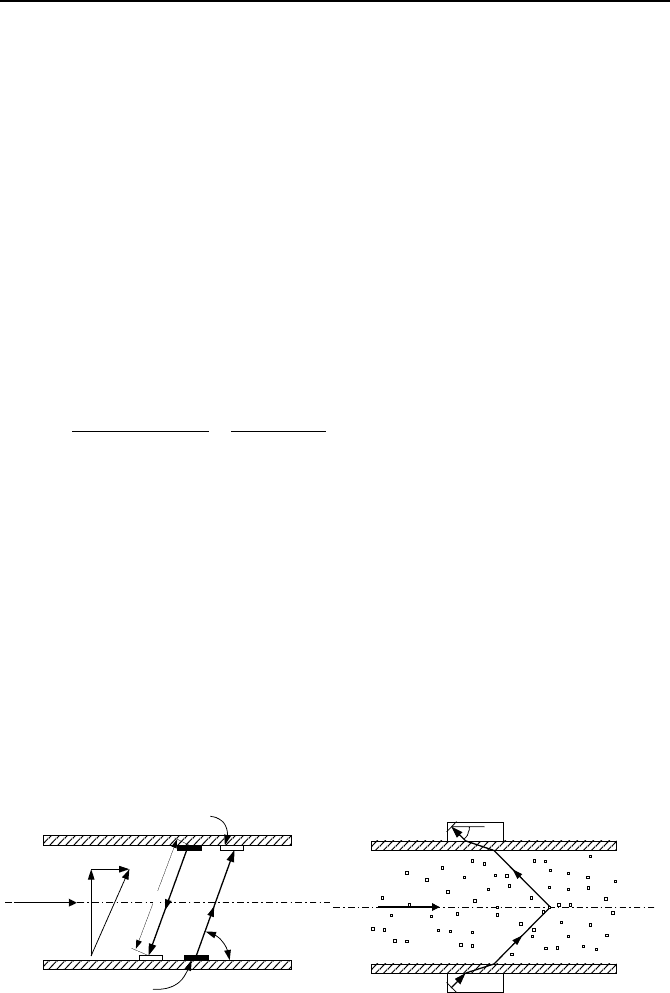
3. Flowmeter Types 739
the generated signals. Major advantages of this flowmeter are lack of moving
parts and that it is noninvasive, resulting in no pressure loss. The major disadvan-
tage is the limitation to electrically conducting liquids. It is not suited for such
non-conducting fluids as hydrocarbons, hence is not widely used in petroleum in-
dustry.
Ultrasonic flowmeter, as shown in Figure VI3.6(a), is based on the travel time
of acoustic waves in a flow field. Some clarification is needed regarding the term
ultrasonic. Some flowmeters, such as a vortex-shedding meter, use ultrasonic
sensing in their data acquisition systems. Ultrasonic flowmeters are of two types:
ultrasonic doppler meter and ultrasonic transit-time meter. The ultrasonic transit
time meter works on the basis that sound waves in the flow direction travel at a
speed faster by 2V compared with the sound waves travelling against the flow.
The time it takes for the wave to travel from the transmitter to the receiver is t
1
=
L/(c + Vcos
α
). Similarly, the time it takes for the wave to travel from the receiver
back to the transmitter is t
2
= L/(c – Vcos
α
). This results in:
c
LV
Vc
LV
t
α
α
α
cos2
cos
cos2
222
≅
−
=∆ VIb.3.4
indicating that the measured time is linearly proportional with the measured flow
velocity. Note that V is the flow velocity and c the speed of sound in the fluid.
The transit-time meter is by far more accurate than a Doppler meter, Fig-
ure VIb.3.6(b). The latter works on the basis of the Doppler frequency shift. This
occurs when sound waves are reflected from an impurity in the fluid. If sound
waves are reflected from stationary objects, there is no change in their wave char-
acteristics wavelength and frequency. However, upon reflection from a moving
target, there will be a shift in the wave characteristics hence the wave would have
new amplitude, period, and frequency. The flow velocity by Doppler flowmeter is
found from V = c
∆f/(2fcos
α
) where f is the transmission frequency and ∆f is the
doppler shift in frequency. Generally noninvasive flowmeters have the advantage
of no moving parts, no induced pressure drop, no need for integration in the piping
system, ease of use, capability to be bi-directional, and associated cost savings.
α
V
c
Flow
L
Receive
r
Transmitter
Flow
Receiver
Transmitter
α
(a) (b)
Figure VIb.3.6. (a) Ultrasonic Transit-Time flowmeter and (b) Ultrasonic Doppler flow-
meter
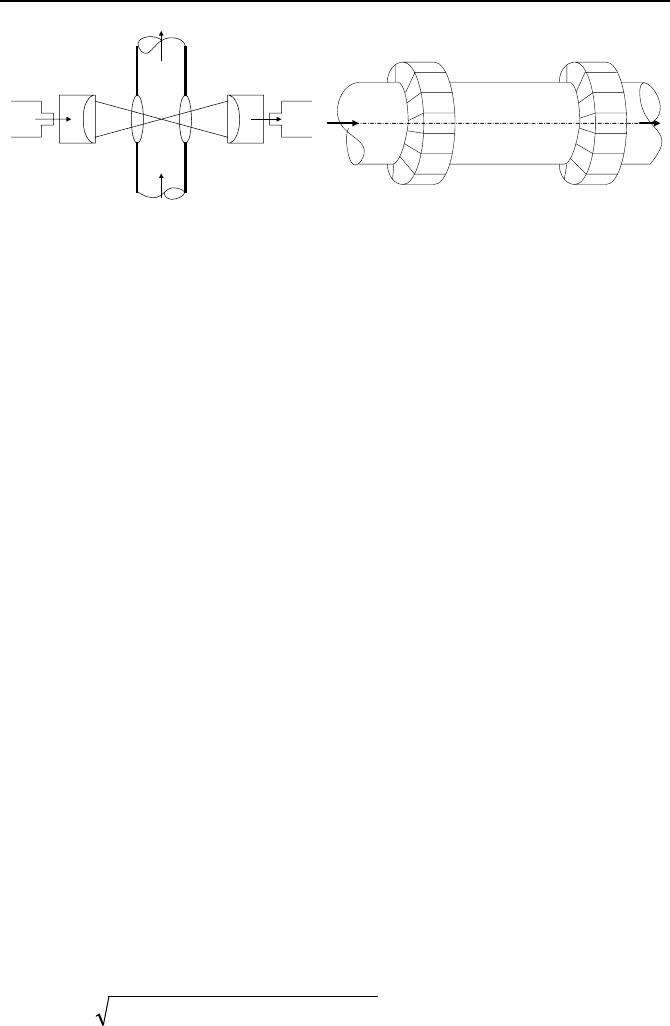
740 VIb Applications: Fundamentals of Flow Measurement
Laser Detector
FLOW
Source Detector
(a) (b)
Figure VIb.3.7. Schematics of (a) Laser Doppler flowmeter; (b) Pulsed Neutron Activa-
tion Flowmeter
Laser Doppler anemometer or LDA is also used to measure flow rate using
the concept of doppler shift. In this method a laser - a coherent monochromatic
light beam - passes through the fluid flow and is highly focused in an LDA. Solid
particles, in the order of 25 microns in the fluid will scatter the light beam. The
scattered light would have a different frequency than the incident light. This is the
Doppler shift. A photo multiplier device receives the scattered beam to electroni-
cally sense the change in frequency with respect to a reference (non-scattered)
beam. Shown in Figure VIb.3.7(a) is a dual-beam LDA with
α
being the angle
between the incident rays. If l is the frequency of the incident ray, the flow veloc-
ity is then given by V =
λ∆f/[2sin(a/2)]. The disadvantage of this method is the
fact that it requires a glass window for light to pass through.
Pulsed neutron activation or PNA is another non-invasive means of measur-
ing flow rate and is included in the class of radioisotope tracer technique. As
shown in Figure VIb.3.7(b), an energetic neutron source is used to induce radioac-
tivity into the flow field. The field velocity is determined by detecting the
γ-ray
emitted from the irradiated liquid, in a detector located downstream of the neutron
source. There are disadvantages associated with this method. PNA uses high-
energy neutrons. For example, for the O
16
(n, p) N
16
reaction, which has a half-life
of 7.14 seconds, the neutron activation threshold is 10.24 MeV. Such high levels
of energy require extensive shielding. Additionally, the neutron source and the
detector should be circumferencially distributed to minimize radiation bias. In-
deed radiation bias occurring due to beam attenuation is another drawback of this
method.
Elbow meter is another means of measuring volumetric flow rate, using the
change of flow momentum and the associated centrifugal force. Lansford corre-
lated the resulting differential pressure to volumetric flow rate to obtain a formula
similar to Equation IIIb.4.3:
[]
{}
)(/)(2V
1 ioo
zzgPPgCA −+−=
ρ
VIb.3.5
where, in this relation, value of C ranges from 0.56 - 0.88 depending on the size
and shape of the elbow.
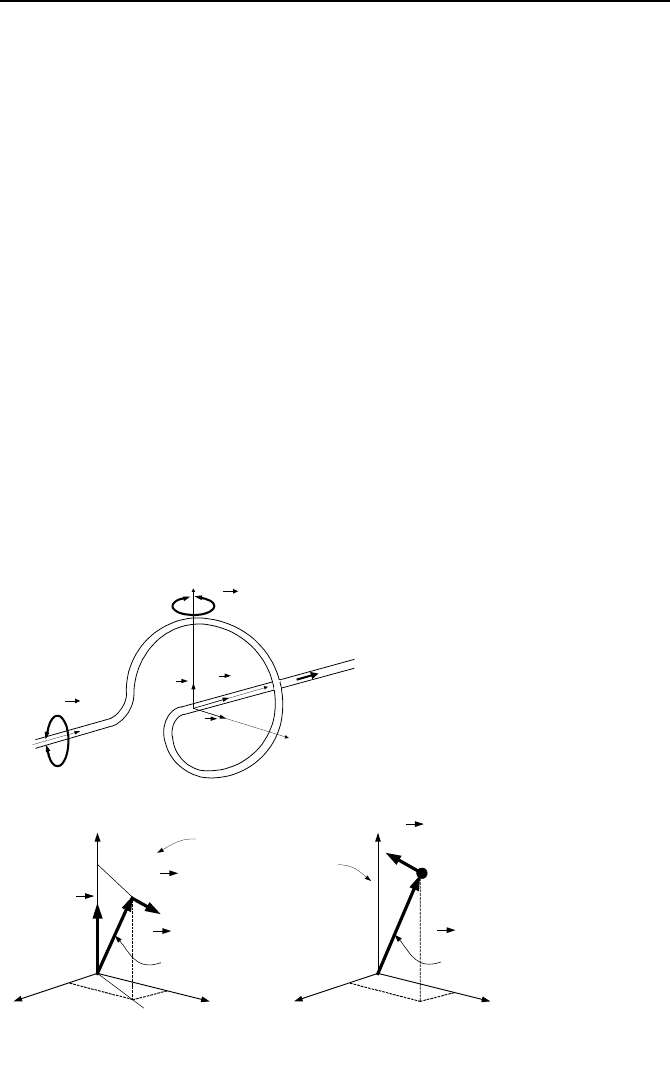
3. Flowmeter Types 741
Flow
x
y
z
ω
1
ω
2
i
j
k
(a)
x
y
z
s
m
X
Y
Z
S
ω
(R
m
)
s
(R
s
)
S
(V
m
)
s
(V
s
)
S
Inertial frame
non-Inertial frame
(b)
Figure VIb.3.8. (a) A Coriolis flowmeter; (b) Depiction of an inertial and a non-inertial
frame
Positive Displacement (PD) is the most widely used flowmeter for flow meas-
urement of liquid and gas for industrial, commercial and residential applications.
A recent survey indicates that the worldwide sale of the positive displacement
flowmeters constituted half of all the flowmeters sold in 2001. Thus more PD
flowmeters are sold than all other types, such as Ultrasonic, Electromagnetic,
∆P
meter, Vortex meter and mass measuring flowmeters combined (Control maga-
zine). The PD flowmeters are of various types. All function on the same principle
of measuring a known volume of the fluid in a distinct compartment that is accu-
rately measured by the manufacturer. The number of these measurements (i.e. the
number of times these compartments are filled and emptied per unit time) would
determine the flow rate. The PD flowmeters are suitable for viscous fluids (such
as oil, paint, varnish, and cosmetics), for low flow rates (as low as about 2 liter/m),
and for corrosive products.
3.3. Mass Measuring Flowmeters
There is no need to measure density in these flowmeters, as mass flow rate is di-
rectly measured. Several such instruments are discussed below.
Coriolis flowmeters are used in the flow measurement of liquids, suspensions,
emulsions, and gases. The coriolis flowmeter is named after the French mathema-
tician Gustave Coriolis who in 1835 showed that an inertial force must be taken
into account when describing the motion of bodies in non-inertial frames. The
